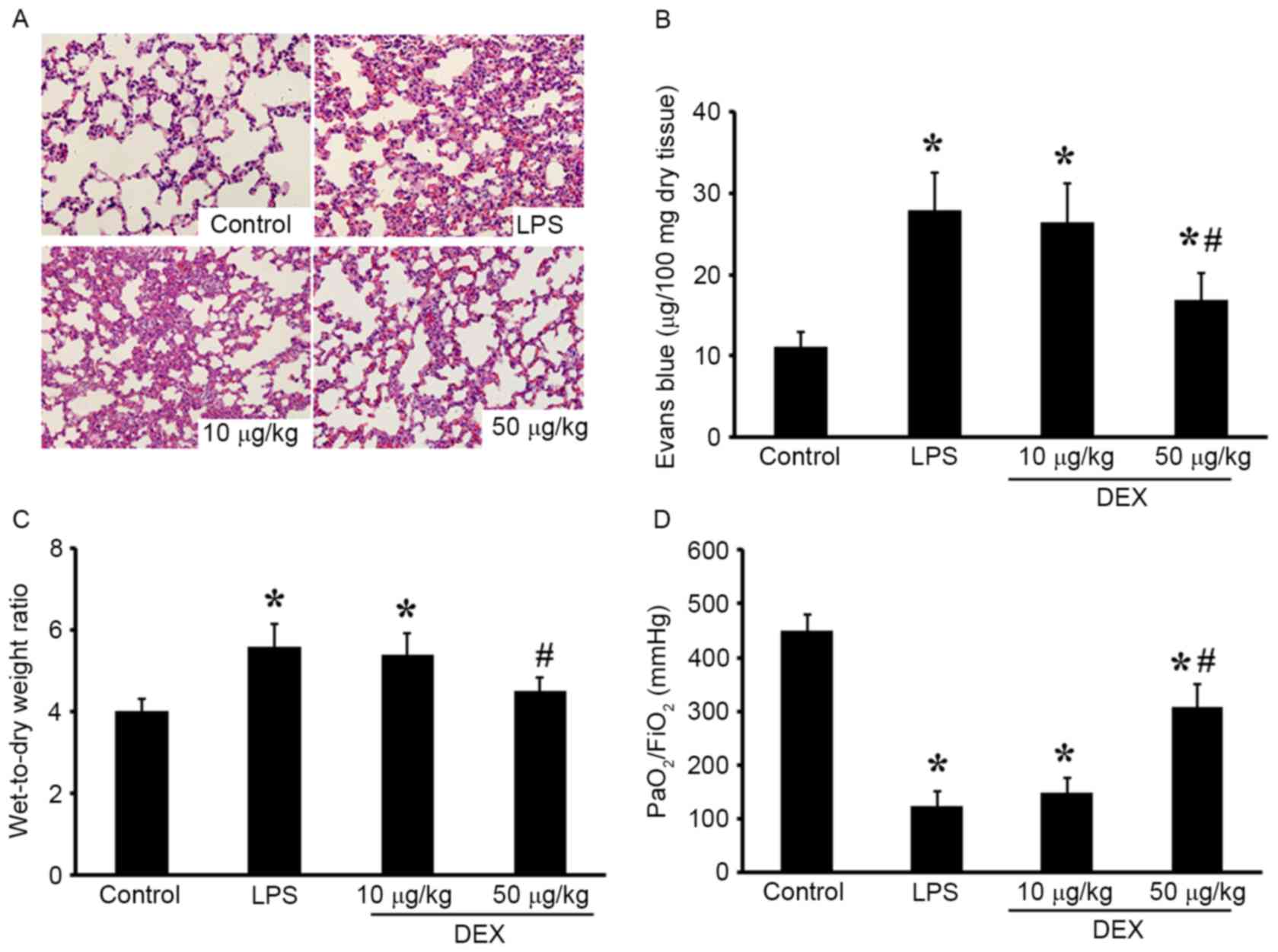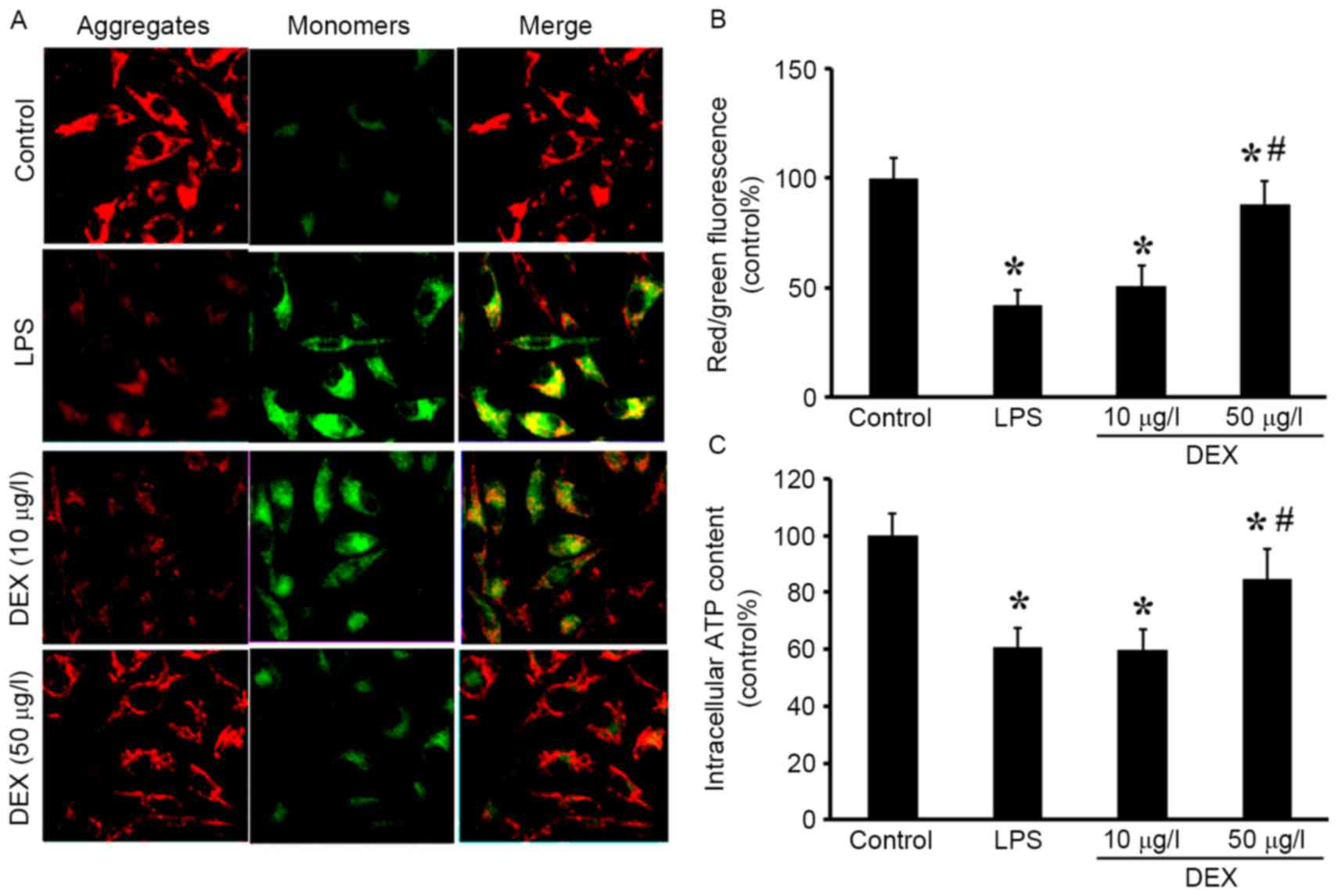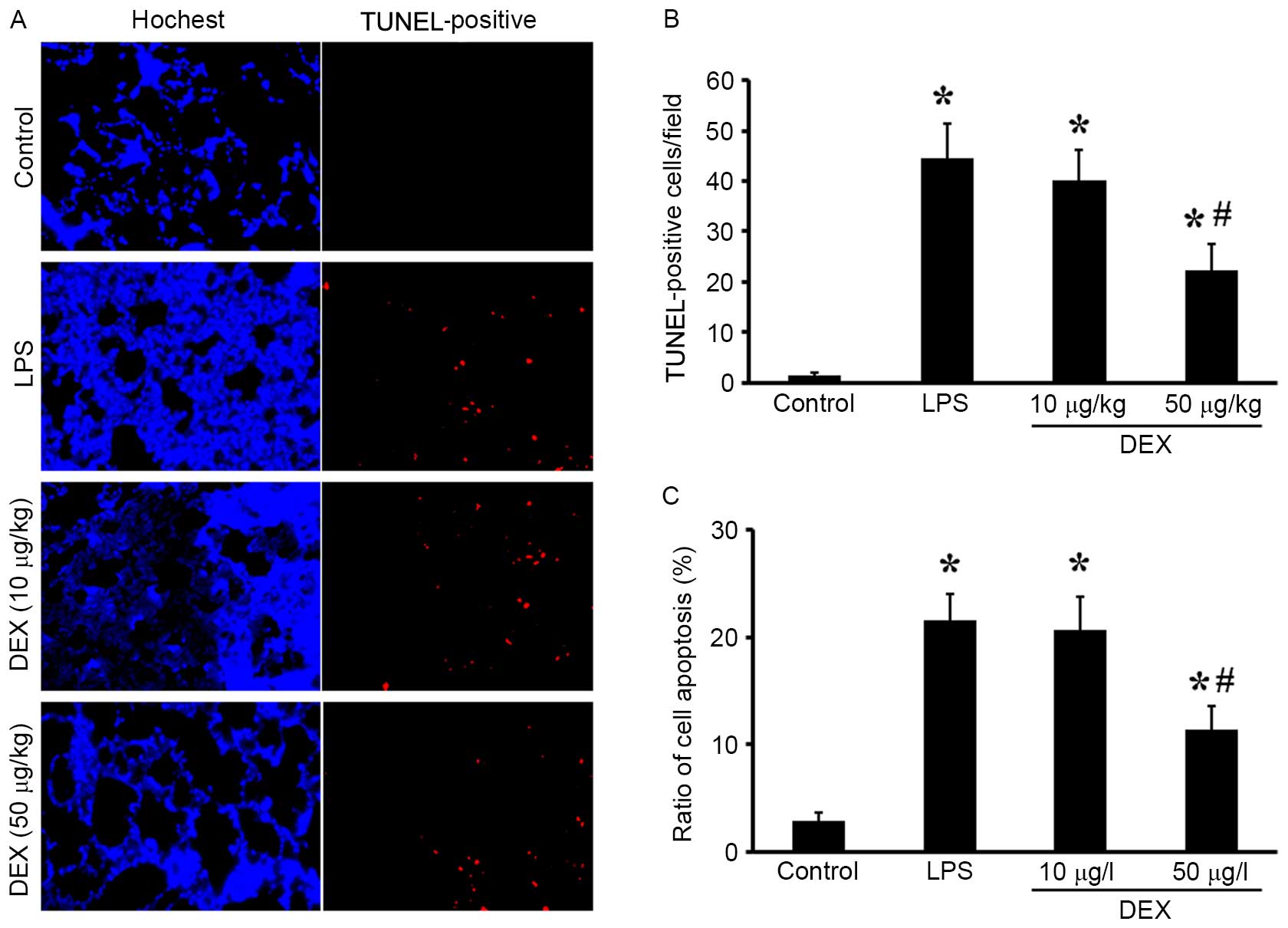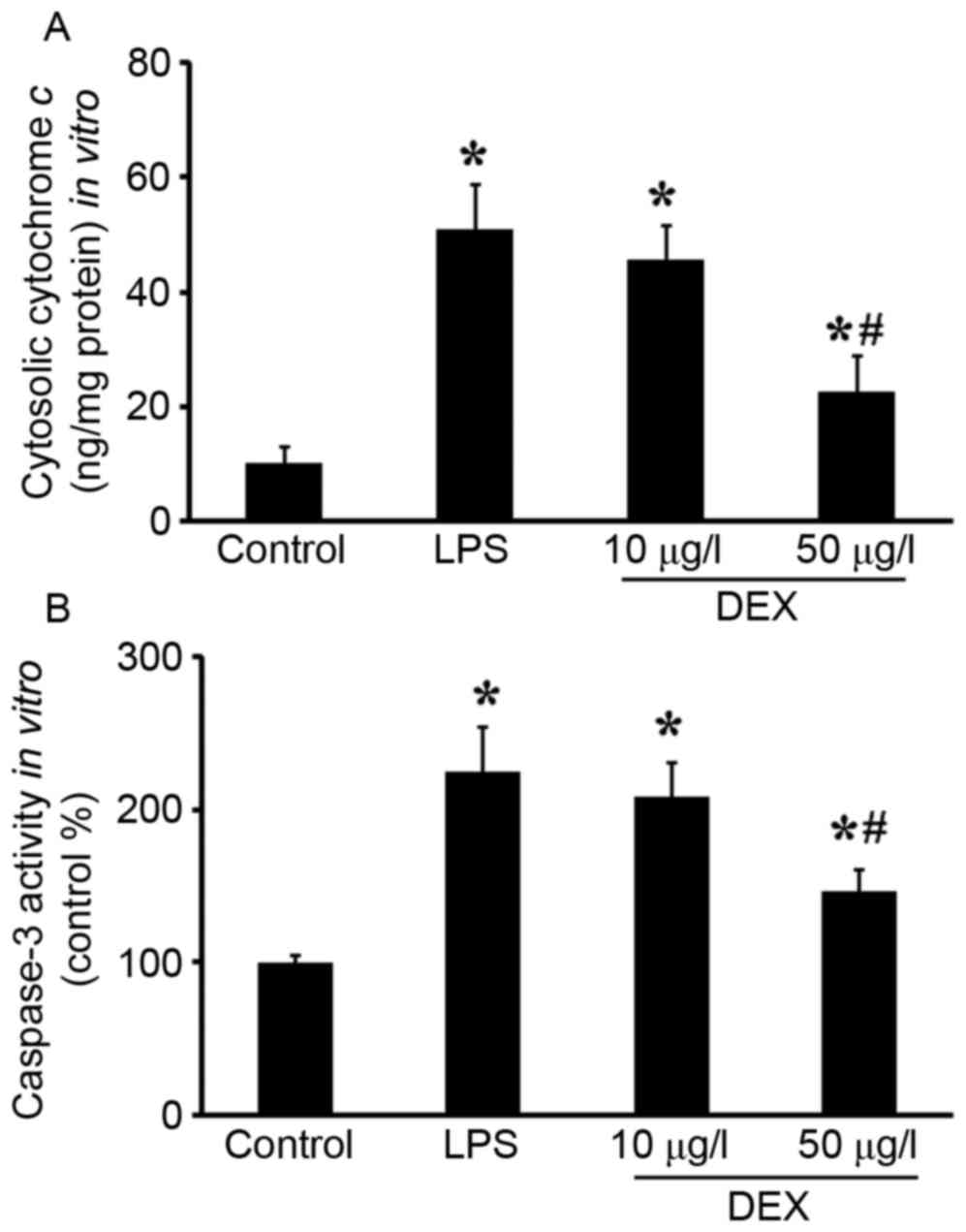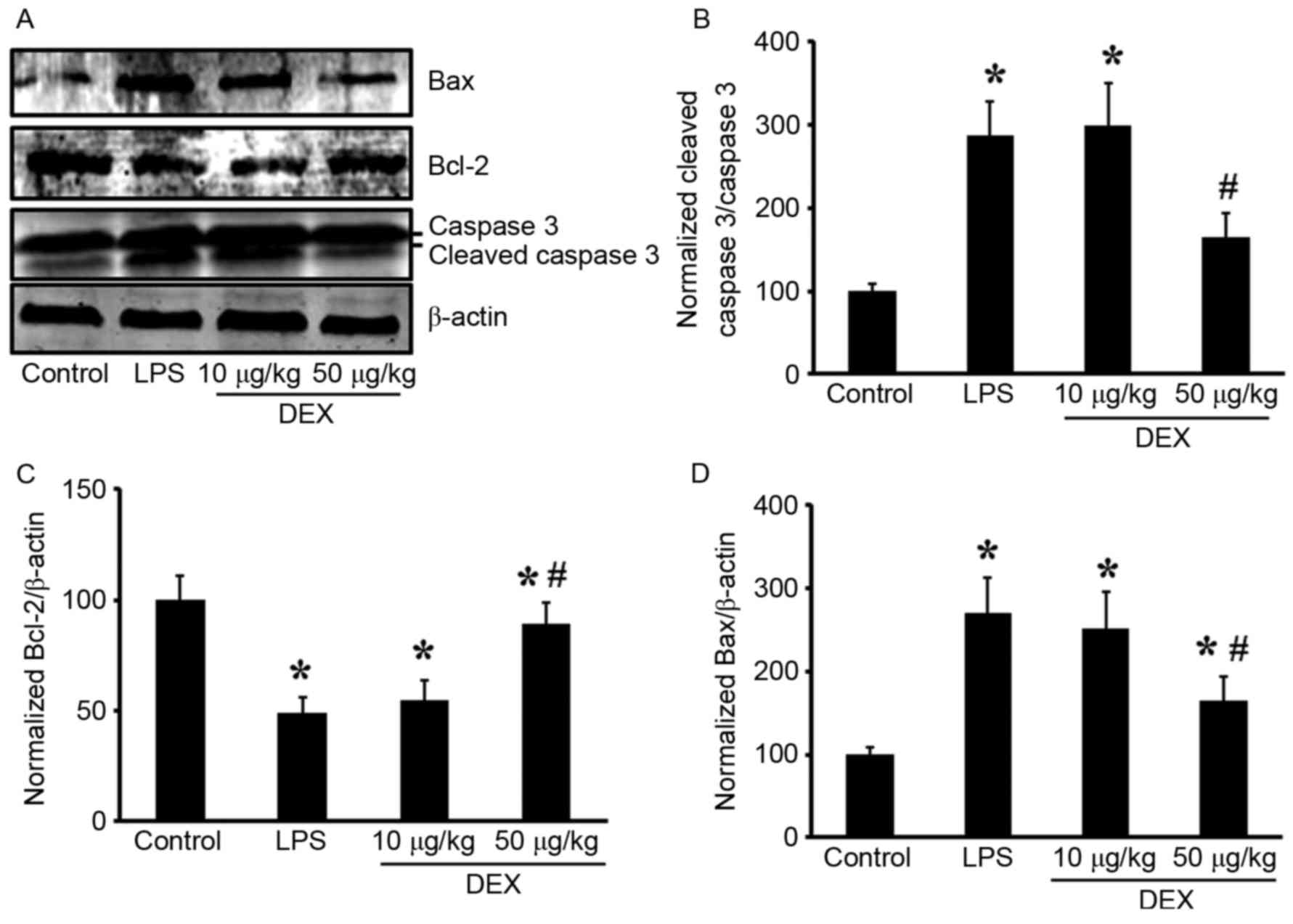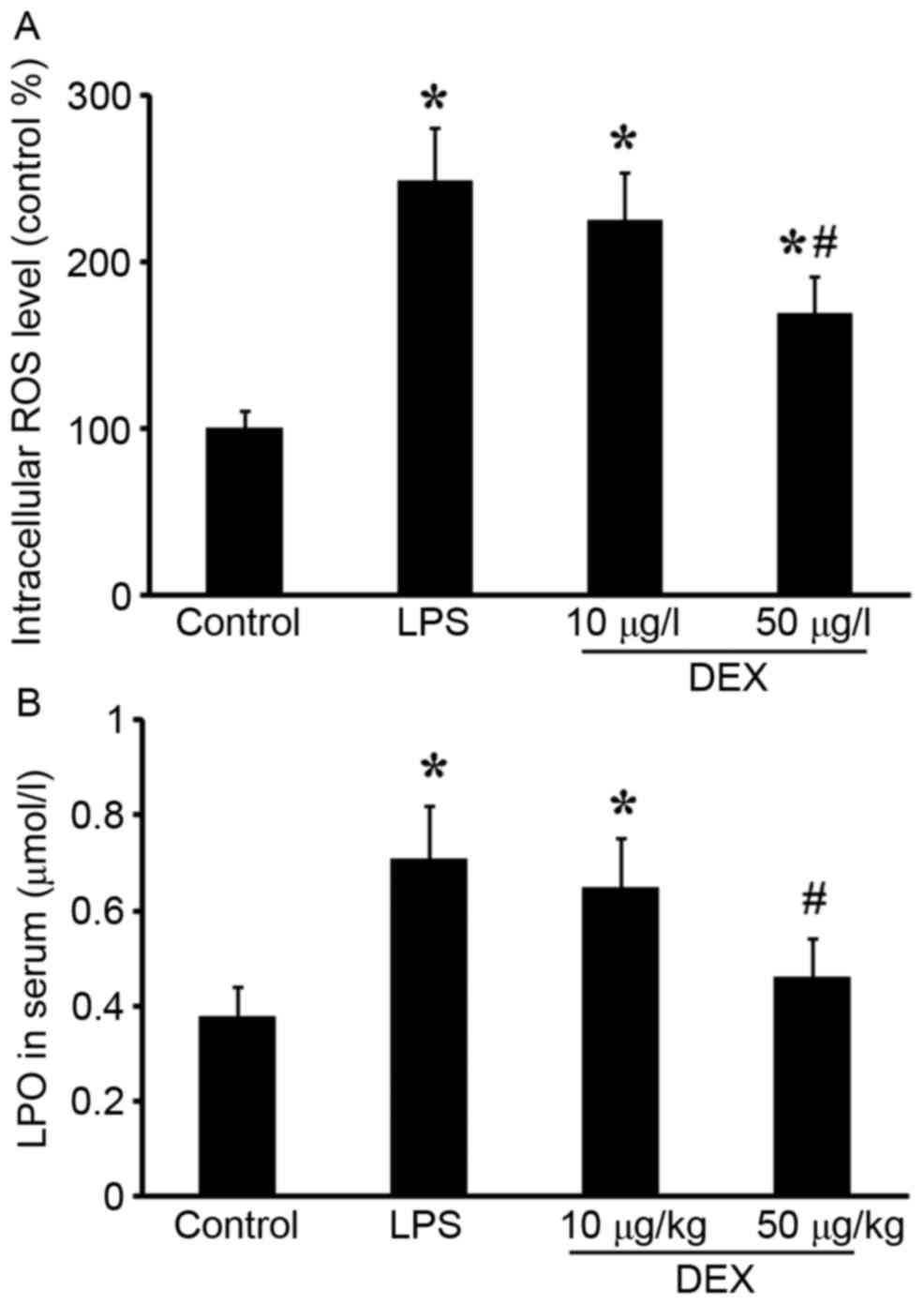Dexmedetomidine attenuates lipopolysaccharide-induced acute lung injury by inhibiting oxidative stress, mitochondrial dysfunction and apoptosis in rats
- Authors:
- Published online on: December 9, 2016 https://doi.org/10.3892/mmr.2016.6012
- Pages: 131-138
-
Copyright: © Fu et al. This is an open access article distributed under the terms of Creative Commons Attribution License.
Abstract
Introduction
Acute lung injury (ALI) and acute respiratory distress syndrome are well-defined and readily recognized clinical disorders caused by numerous clinical insults to the lung or due to predispositions to lung injury (1–3). ALI is a frequent complication following sepsis in critically ill patients and lipopolysaccharide (LPS) is thought to be the most important pathogen that leads to the development of ALI in sepsis (4,5).
Mitochondrial damage is associated with numerous human diseases, including ALI (6–9). Mitochondria are involved and serve a central role in the integration and circulation of death signals initiating inside the cells, including oxidative stress and DNA damage, and in regulating cell death/apoptosis pathways (10–12). Mitochondrial regulation of apoptosis is predominantly mediated via the release of cytochrome c, apoptosis-inducing factor (AIF), and second mitochondria-derived activator of caspases (Smac) and ultimately caspase activation (13–15).
Dexmedetomidine (DEX), a highly selective and potent α2-adrenoreceptor agonist, provides excellent sedation and analgesia with minimal cardiovascular effects. Previous studies have shown that DEX attenuates LPS, ischemia-reperfusion and ventilator-induced lung injury in animal models; however, the mechanism remains unclear (16–19). Additionally, the anti-inflammatory and antiapoptotic effects of DEX have been demonstrated in previous studies (20–23). DEX has also been reported to have an effect on mitochondrial permeability transition pore (mPTP) in neutrophil and isolated rat hearts following ischemia/reperfusion injury (24–26). The present study hypothesized that DEX may provide protective effect against LPS-induced ALI by alleviating oxidative stress, mitochondrial damage and mitochondria-dependent apoptosis.
Materials and methods
Animals
All experimental protocols were approved by the Animal Care and Use Committee of the Southern Medical University (Guangzhou, China). The care of animals was in accordance with the National Institute of Health guidelines and with those of the Chinese National guidelines. A total of 24 Male Sprague-Dawley rats (weight, 180–220 g) were purchased from the Experimental Animal Center at South Medical University (Guangzhou, China) and were allowed to acclimate for 1 week prior to experiments. Animals were housed in individual cages in a temperature-controlled (25±2°C) room, under a 12 h light/dark cycle, with ad libitum access to food and water.
Animal model
As previously described (27), ALI was induced by intratracheal administration of LPS. Briefly, the animals were intramuscularly anesthetized with an injection of sodium pentobarbital (30 mg/kg). The rats were placed in a supine position on a warming device and the trachea was surgically exposed by a cervical middle line incision in the skin. The rats were subsequently challenged intratracheally with either 0.5 ml sterile normal saline (NS) alone or 0.5 ml NS with LPS (5 mg/kg body weight; Escherichia coli 0111:B4; Sigma-Aldrich; Merck Millipore, Darmstadt, Germany) stabbing the trachea with a microsyringe. Prior to ALI induction, the rats were pretreated with DEX (10 or 50 µg/kg) for 30 min. NS was used as the vehicle control.
Cell culture and stimulation
Rat type I alveolar epithelial cells (AECs) were obtained from ScienCell (San Diego, CA, USA) and grown at 37°C in 5% CO2 in Dulbecco's modified Eagle medium (DMEM, Sigma-Aldrich; Merck Millipore), containing low glucose, penicillin (100 U/ml, Sigma-Aldrich; Merck Millipore), streptomycin (100 units, Sigma-Aldrich; Merck Millipore) and 10% bovine serum (Sigma-Aldrich; Merck Millipore). The AECs were respectively pretreated with 10 and 50 µg/l DEX for 30 min, followed by stimulation of 5 µg/ml LPS for 12 h. DMEM was used as a vehicle control.
Experimental design
In vivo, rats were intramuscularly anesthetized with an injection of sodium pentobarbital (30 mg/kg), and were then sacrificed by decollation at 24 h post-LPS treatment. The lung injury oxygenation index (PaO2/FIO2), histopathological changes, lung microvascular permeability and wet-to-dry (W/D) weight ratio were measured. To investigate the underlying mechanisms of DEX treatment in LPS-induced ALI, terminal deoxynucleotidyl transferase dUTP nick end labeling (TUNEL) staining, serum lipid peroxidation, caspase 3 activity, and the expression levels of Bax, Bcl-2 and cleaved caspase 3 were investigated.
In vitro, following 12 h stimulation, oxidative stress, as determined by reactive oxygen species (ROS) production, mitochondrial function, as determined by mitochondrial membrane potential (MMP) and cellular ATP, and mitochondria-dependent apoptosis, as determined by cell apoptotic rate, cytochrome c release and caspase-3 activity were detected.
Histological examination
The lungs were harvested 24 h following LPS injection. The right middle lobes of the lungs were fixed with 10% formalin, embedded in paraffin and sectioned (4 µm thickness). Following deparaffinization and rehydration, the tissue sections were stained with hematoxylin and eosin. The pathological sections were observed and assessed in a blinded manner.
Lung microvascular permeability assay
The permeability assay was performed, as previously described (4). Briefly, Evans blue (EB; 20 mg/kg; Sigma-Aldrich) was injected intravenously through the femoral vein. After 30 min, the animals were intramuscularly anesthetized with an injection of sodium pentobarbital (30 mg/kg), and were then sacrificed by decollation, and a midline thoracotomy was performed. The superior and inferior vena cava were subsequently ligated, the aorta was transected, and 20 ml normal saline solution was injected into the right ventricle at a pressure of 20 cm H2O to wash out the pulmonary intravascular content. A sample of lung tissue was weighed, homogenized and immersed in N,N-dimethylformamide (Sigma-Aldrich). The homogenate was incubated at room temperature for 48 h. Eluted EB was measured at 620 nm using an automatic microplate reader (SpectraMax M5; Molecular Devices, Sunnyvale, CA, USA), and the quantity was expressed as µg/100 mg dry tissue.
Measurement of lung W/D weight ratio
The harvested wet lung was weighed and subsequently placed in an oven for 48 h at 80°C, followed by weighing when it was dried. The lung W/D weight ratio was calculated.
Oxygenation index (PaO2/FiO2) analysis
At 24 h following ALI (or sham), animals were anesthetized and administered endotracheal intubation with a 20-gauge catheter. The animals were mechanically ventilated with pure oxygen at 7 ml/kg (120 breaths/min). Following 20 min ventilation, the arterial blood was obtained from the carotid artery and measured using a commercial blood gas analyzer (ABL8000; Radiometer Copenhagen, Copenhagen, Denmark).
Measurement of mitochondrial membrane potential (MMP) in vitro
The MMP was determined using the potential-sensitive fluorescent dye, JC-1. This dual-emission probe changes color from red-orange to green as the mitochondrial membrane depolarizes. The JC-1 (5 µmol/l) was loaded onto AECs for 15 min at 37°C. The results were visualized using a confocal microscope (×650; LSM 780 NLO; Carl Zeiss, Jena, Germany). Alternatively, the fluorescence intensity was monitored using flow cytometry (BD Immunocytometry Systems, Franklin Lakes, NJ, USA) at an excitation/emission of 525/590 nm.
Measurement of cellular ATP in vitro
Intracellular ATP was determined using a luciferase-based assay (CellTiter-Glo, Madison, WI, USA), according to the manufacturer's protocol. Following the addition of 100 µl CellTiter-Glo reagent to 100 µl cell suspension containing 10,000 cells in each well of a standard opaque-walled 96-well plate, the plates were allowed to incubate at room temperature for 10 min, and the luminescence was recorded in an automatic microplate reader (SpectraMax M5; Molecular Devices).
TUNEL staining
Lung histopathological slides were dewaxed and incubated with proteinase K. The slides were stained using a TUNEL kit (Biovision, Mountain View, CA, USA), according to the manufacturer's instructions. Subsequently, the cells were counterstained with Hoechst 33258 (Sigma-Aldrich) and examined under a fluorescence microscope (ECLIPSE FNl, Nikon).
Measurement of cell apoptosis in vitro
Cell apoptosis was detected using an annexin V-FITC apoptosis detection kit (BD Biosciences, Franklin Lakes, NJ, USA). Following induction with H2O2, the cells (~1×105 cells/ml) were washed twice with PBS and suspended in 1X binding buffer. A total of 5 µl annexin V-FITC and 10 µl propidium iodide (PI; 50 µg/ml; Sigma-Aldrich) was added to the cell suspension. Following incubation at room temperature for 20 min in the dark, the fluorescence of the cells was determined immediately using a flow cytometer (BD Immunocytometry Systems).
Measurement of cytosolic cytochrome c in vitro
Cytosolic cytochrome c content was estimated using a cytochrome c ELISA kit (Biovision), as described previously (28). The cell homogenates were centrifuged (10,000 × g for 60 min at 4°C) and the supernatant (cytosolic fraction) was collected and subjected to protein estimation using the bicinchoninic acid method (BCA). The samples were treated with a conjugate reagent, transferred to a cytochrome c antibody-coated microwell plate and incubated at room temperature for 60 min. The wells were washed and treated with a substrate and incubated for 30 min at room temperature, followed by the addition of a stop solution. The optical density was measured at 450 nm using an automatic microplate reader (SpectraMax M5). A serial dilution of cytochrome c calibrator was subjected to the assay, along with the samples. The values were plotted and the concentration of cytochrome c was calibrated from the standard curve.
Measurement of caspase 3 activity in vitro
Caspase 3 activity was determined using a caspase 3 activity assay kit, according to the manufacturer's instructions (Biovision). The cells were lysed in caspase 3 sample lysis buffer. The homogenates were centrifuged at 10,000 × g and the supernatant was collected for protein estimation using BCA and for the caspase 3 assay. The cell lysates were exposed to the DEVD substrate conjugate provided in the kit. The sample was measured in an automatic microplate reader (SpectraMax M5) at excitation of 400 nm and emission of 505 nm.
Western blot analysis for Bax, Bcl-2 and cleaved caspase 3 in vivo
The lung tissues were homogenized and analyzed by western blotting. Protein concentrations were determined using the BCA method. An equal quantity of protein was loaded onto 10% sodium dodecyl sulphate-polyacrylamide gels for electrophoresis. Following electrophoresis, the proteins were electroblotted onto polyvinylidene difluoride membranes. Membranes were blocked with blocking solution (5% skimmed milk diluted with PBS) at room temperature for 2 h, followed by incubation with primary antibodies against β-actin (1:5000 dilution; cat. no. ab8227; Abcam, Cambridge, UK), Bax (1:1,000 dilution; cat. no. ab32503; Abcam), Bcl-2 (1:1,000 dilution; cat. no. ab59348; Abcam) and cleaved caspase 3 (1:1,000 dilution; cat. no. ab13847; Abcam) overnight at 4°C. The membranes were subsequently incubated with horseradish peroxidase-conjugated secondary antibody (1:5,000, cat. no. ab6721, Abcam), and the protein expression was detected using an enhanced chemiluminescence reagent [cat. no. abs920B-500, Absin Biotechnology Co., Ltd., Shanghai, China].
Measurement of ROS levels in vitro
Intracellular ROS levels were assessed using a DCFH-DA probe (Sigma-Aldrich). The cells were treated with DCFH-DA (10 µM) after LPS stimulation for 20 min at 37°C. Following incubation, the cells were washed and analyzed using an automatic microplate reader (SpectraMax M5). The relative intensity of DCF fluorescence was determined at a wavelength of 535 nm, as compared with the sham group cells.
Measurement of lipid peroxides in vivo
The serum was obtained as described above. Lipid peroxides (LPOs) were measured using a commercially available kit (Cayman Chemical Co., Ann Arbor, MI, USA), according to the manufacturer's protocol. The LPO content was measured at 500 nm using an automatic microplate reader (SpectraMax M5).
Statistical analysis
All variables are presented as the mean ± standard deviation. Differences between the groups were determined using one-way analysis of variance with the least significant difference multiple-comparison test and Student's t-test when appropriate. P<0.05 was considered to indicate a statistically significant difference.
Results
DEX attenuates LPS-induced ALI in rats
The present study examined the effects of DEX on LPS-induced ALI in rats. Lung histological sections of LPS-challenged rats exhibited accumulation of a large number of neutrophils in the intra and interalveolar space, a thickened alveolar wall, less alveolar space and interstitial congestion, and these alterations were markedly attenuated by pretreatment with DEX (50 µg/kg) (Fig. 1A). Additionally, the lung microvascular permeability, reflected by EB content in lung tissue and W/D weight ratio of the lung were increased in LPS-challenged rats compared with the control animals. DEX pretreatment reduced the EB content in lung and the W/D weight ratio of lung compared with the LPS group (P<0.05 compared with the LPS group for 50 µg/kg DEX group; P>0.05 compared with the LPS group for 10 µg/kg DEX group; Fig. 1B-D). In addition, the PaO2/FiO2 was significantly decreased in LPS-challenged rats, which was improved by DEX treatment (P<0.05 compared with the LPS group for 50 µg/kg DEX group; P>0.05 compared with the LPS group for 10 µg/kg DEX group; Fig. 1D). These results indicated that DEX pretreatment attenuated LPS-induced ALI in rats.
DEX prevents LPS-induced mitochondrial dysfunction
To establish whether DEX attenuated LPS-induced mitochondrial dysfunction, the level of MMP and cellular ATP levels were evaluated. JC-1, the potential-sensitive fluorescent dye, forms aggregates in normally polarized mitochondria and monomers in damaged and depolarized mitochondria. The color of this dual-emission probe changed from red-orange to green as the mitochondrial membrane turned depolarized. As shown in Fig. 2A and B, the control cells were clearly red. However, LPS exposure rapidly caused MMP dissipation, as shown by the increase in green fluorescence and the concomitant disappearance of red fluorescence. Pretreatment with DEX significantly attenuated the changes in MMP, as indicated by the repression of green fluorescence and restoration of red fluorescence (P<0.05 compared with the LPS group for 50 µg/l DEX group; P>0.05 compared with the LPS group for 10 µg/l DEX group). In addition, the intracellular ATP level was decreased by LPS stimulation compared with the control group, indicating mitochondrial dysfunction in the AECs. Following pretreatment with the DEX, the ATP levels were increased compared with the LPS group (P<0.05 compared with the LPS group for 50 µg/l DEX group; P>0.05 compared with the LPS group for 10 µg/l DEX group; Fig. 2C).
DEX inhibits the LPS-induced mitochondrial-dependent apoptosis
To determine the protective effects of DEX against LPS-induced apoptosis, TUNEL and annexin-V/PI double staining assays were performed. In vivo, LPS-challenged animals exhibited a significant increase in red marked apoptotic cells, which was reduced by DEX (50 µg/kg) pretreatment (Fig. 3A and B). In vitro, the rates of cell apoptosis were markedly increased following LPS exposure, compared with the control group, and were subsequently reduced by DEX pretreatment (P<0.05 compared with the LPS group for 50 µg/l DEX group; P>0.05 compared with the LPS group for 10 µg/l DEX group; Fig. 3C).
Mitochondrial regulation of apoptosis is mediated through the release of cytochrome c, AIF and Smac, and ultimately caspase activation. In present study, cytochrome c release, caspase 3 activity and cleaved caspase 3 expression were detected. As shown in Fig. 4, increased cytosolic cytochrome c and caspase 3 activities were observed in vitro, which was reduced by DEX pretreatment (P<0.05 compared with the LPS group for 50 µg/l DEX group; P>0.05 compared with the LPS group for 10 µg/l DEX group). In the lungs, pretreatment with DEX (50 µg/kg) inhibited LPS-induced cleaved caspase 3 upregulation (Fig. 5A and B; P<0.05 compared with the LPS group for 50 µg/kg DEX group; P>0.05 compared with the LPS group for 10 µg/kg DEX group).
Additionally, the present study investigated the changes in expression levels of the Bcl-2 family of proteins (Bax and Bcl-2) in lung tissue. LPS inhalation resulted in downregulation of the Bcl-2 protein, and DEX prevented this decrease (P<0.05 compared with the LPS group for 50 µg/kg DEX group; P>0.05 compared with the LPS group for 10 µg/kg DEX group; Fig. 5A and C). Expression of the pro-apoptotic protein Bax was upregulated by LPS induction and inhibited by DEX pretreatment (P<0.05 compared with the LPS group for 50 µg/kg DEX group; P>0.05 compared with the LPS group for 10 µg/kg DEX group; Fig. 5A and D). These results indicated that intratracheal administration LPS induced lung cell apoptosis, which can be significantly alleviated by treatment with DEX.
DEX alleviates LPS-induced oxidation
Oxidative stress is one of the most important mediators of mitochondrial dysfunction and apoptotic signaling. In vitro, a fluorescent probe, DCFH-DA, was used as a specific marker for quantitative mitochondrial ROS accumulation. LPS-induced mitochondrial ROS production was evidenced by increased intensity of DCF fluorescence in LPS-challenged rats compared with the control animals. This increase was attenuated by pretreatment with DEX (50 µg/l) (P<0.05 compared with the LPS group for 50 µg/l DEX group; P>0.05 compared with the LPS group for 10 µg/l DEX group; Fig. 6A). To evaluate the oxidative stress in vivo, LPO levels were determined in rat serum. The LPO levels significantly increased in the LPS-challenged rats, which was subsequently reduced by pretreatment with DEX (50 µg/kg) (P<0.05 compared with the LPS group for 50 µg/kg DEX group; P>0.05 compared with the LPS group for 10 µg/kg DEX group; Fig. 6B).
Discussion
Gram-negative organisms account for ~50% of infections predisposing to ALI, often in the setting of pneumonia or sepsis (27). LPS endotoxin is the critical mediator of the organ dysfunction and mortality associated with severe Gram-negative infections (29,30). It is well-established that intratracheal administration of LPS can induce a model of ALI (4,27). In the present study, to investigate whether DEX attenuates sepsis-induced ALI, ALI rat model was established through intratracheal injection of LPS (5 mg/kg), according to a previous report (4). The present study observed significant lung injuries and dysfunction following LPS administration, evidenced by deterioration of histopathology, increased vascular permeability, W/D weight ratio of the lung and decreased PaO2/FIO2, which is consistent with other studies (2,4). In previous studies, the protective effect of DEX against ALI has been demonstrated in several models (16,17,19). Following pretreatment of DEX (50 µg/kg), LPS-induced ALI was attenuated, which was reflected by improved histopathological changes, vascular permeability, lung water content and PaO2/FIO2.
DEX has been reported to exert protective effect against ischemia/reperfusion injury in isolated rat hearts and may be associated with inhibiting the opening of mPTP (24). In addition, DEX has been demonstrated to induce human neutrophil apoptosis, which is associated with the caspase cascade and loss of MMP (26). To explore the mechanism behind the attenuation of ALI performed by DEX, the mitochondrial function and mitochondrial-dependent apoptosis were investigated in the present study. A reduction in MMP was demonstrated through JC-1 staining. LPS-induced MMP dissipation was reflected by the fluorescence changes in vivo and in vitro, which was subsequently improved by DEX treatment. MMP is dissipated in response to the arrest of the function of the respiratory complexes (I–V), which contributes to an inhibition of ATP biosynthesis. In vitro, DEX inhibited LPS-induced cellular ATP decrease.
Mitochondrial-dependent apoptosis is activated through the mitochondrial release of cytochrome c, AIF and Smac (28). Cytochrome c, once in the cytosol, acts to release the apoptosome assembly from the apoptotic protease-activating factor 1, ATP and procaspase-9, leading to cellular morphological and functional alterations via the activation of caspase 3 and caspase 7 (13). To further elucidate the present hypothesis of mitochondrial mediated apoptosis, cytosolic cytochrome c levels were estimated with a cytochrome c ELISA kit. It was demonstrated that DEX improved LPS-induced mitochondrial release of cytochrome c into the cytoplasm. Additionally, the present results demonstrated that DEX prevents LPS-induced caspase 3 activation in vivo and in vitro.
Mitochondrial regulation of apoptosis is also regulated by members of the Bcl-2 family of proteins (31,32). The Bcl family consists of both antiapoptotic (Bcl-2, Bcl-xL) and proapoptotic (BAK, Bax) factors. The pro-apoptotic members of this family, including Bax, trigger the release of mitochondrial apoptogenic factors into the cytoplasm by acting on the mPTP, thereby leading to caspases activation. While the antiapoptotic members serve a contrasting role to prevent apoptosis. In the present study, the expression levels of Bax and Bcl-2 were detected by western blotting in the rat samples. The results suggested that LPS-induced upregulation of Bax and downregulation of Bcl-2, which were improved by DEX treatment.
Oxidative stress is one of the most important mediators of mitochondrial dysfunction and apoptotic signaling (33,34). mPTP are major targets of ROS, from which Smac and cytochrome c are released into the cytoplasm after mPTP opening (7,35). The protective effect of DEX has been demonstrated in other diseases. In the present study, DEX inhibits LPS-induced oxidative stress, as evidenced by decreased cellular ROS and serum LPO levels following LPS stimulation. It is quite possible that mitochondrial oxidative stress serves an important role in the release of cytochrome c into the cytoplasm. DEX, by its antioxidant activity, may have prevented this effect.
In conclusion, the present study has provided evidence to suggest that DEX exerted significant attenuation of LPS-induced ALI in a rat model. It was also revealed that the potential mechanism of this action is through amelioration of oxidative stress, mitochondrial dysfunction and mitochondrial-dependent apoptosis.
Acknowledgements
The present study was supported by the National Natural Science Foundation of China (no. 81500066).
References
|
Aschner Y, Zemans RL, Yamashita CM and Downey GP: Matrix metalloproteinases and protein tyrosine kinases: Potential novel targets in acute lung injury and ARDS. CHEST. 146:1081–1091. 2014. View Article : Google Scholar : PubMed/NCBI | |
|
Xu Y, Ito T, Fushimi S, Takahashi S, Itakura J, Kimura R, Sato M, Mino M, Yoshimura A and Matsukawa A: Spred-2 deficiency exacerbates lipopolysaccharide-induced acute lung inflammation in mice. PLOS One. 9:e1089142014. View Article : Google Scholar : PubMed/NCBI | |
|
Ito Y, Correll K, Schiel JA, Finigan JH, Prekeris R and Mason RJ: Lung fibroblasts accelerate wound closure in human alveolar epithelial cells through hepatocyte growth factor/c-Met signaling. Am J Physiol Lung Cell Mol Physiol. 307:L94–L105. 2014. View Article : Google Scholar : PubMed/NCBI | |
|
Gonzales JN, Gorshkov B, Varn MN, Zemskova MA, Zemskov EA, Sridhar S, Lucas R and Verin AD: Protective effect of adenosine receptors against lipopolysaccharide-induced acute lung injury. Am J Physiol Lung Cell Mol Physiol. 306:L497–L507. 2014. View Article : Google Scholar : PubMed/NCBI | |
|
Martínez-González I, Roca O, Masclans JR, Moreno R, Salcedo MT, Baekelandt V, Cruz MJ, Rello J and Aran JM: Human mesenchymal stem cells overexpressing the IL-33 antagonist soluble IL-1 receptor-like-1 attenuate endotoxin-induced acute lung injury. Am J Respir Cell Mol Biol. 49:552–562. 2013. View Article : Google Scholar : PubMed/NCBI | |
|
Wang W, Xie Q, Zhou X, Yao J, Zhu X, Huang P, Zhang L, Wei J, Xie H, Zhou L and Zheng S: Mitofusin-2 triggers mitochondria Ca2+ influx from the endoplasmic reticulum to induce apoptosis in hepatocellular carcinoma cells. Cancer Lett. 358:47–58. 2015. View Article : Google Scholar : PubMed/NCBI | |
|
Sinha K, Das J, Pal PB and Sil PC: Oxidative stress: The mitochondria-dependent and mitochondria-independent pathways of apoptosis. Arch Toxicol. 87:1157–1180. 2013. View Article : Google Scholar : PubMed/NCBI | |
|
Liu G, Zhang J, Chen H, Wang C, Qiu Y, Liu Y, Wan J and Guo H: Effects and mechanisms of alveolar type II epithelial cell apoptosis in severe pancreatitis-induced acute lung injury. Exp Ther Med. 7:565–572. 2014.PubMed/NCBI | |
|
Bhandari V, Choo-Wing R, Lee CG, Zhu Z, Nedrelow JH, Chupp GL, Zhang X, Matthay MA, Ware LB, Homer RJ, et al: Hyperoxia causes angiopoietin 2-mediated acute lung injury and necrotic cell death. Nat Med. 12:1286–1293. 2006. View Article : Google Scholar : PubMed/NCBI | |
|
Kujoth GC, Hiona A, Pugh TD, Someya S, Panzer K, Wohlgemuth SE, Hofer T, Seo AY, Sullivan R, Jobling WA, et al: Mitochondrial DNA mutations, oxidative stress, and apoptosis in mammalian aging. Science. 309:481–484. 2005. View Article : Google Scholar : PubMed/NCBI | |
|
Green DR and Kroemer G: The pathophysiology of mitochondrial cell death. Science. 305:626–629. 2004. View Article : Google Scholar : PubMed/NCBI | |
|
Khalil WK, Assaf N, ElShebiney SA and Salem NA: Neuroprotective effects of bee venom acupuncture therapy against rotenone-induced oxidative stress and apoptosis. Neurochem int. 80:79–86. 2015. View Article : Google Scholar : PubMed/NCBI | |
|
Lakhani SA, Masud A, Kuida K, Porter GA Jr, Booth CJ, Mehal WZ, Inayat I and Flavell RA: Caspases 3 and 7: Key mediators of mitochondrial events of apoptosis. Science. 311:847–851. 2006. View Article : Google Scholar : PubMed/NCBI | |
|
Chen CH, Chen SJ, Su CC, Yen CC, Tseng TJ, Jinn TR, Tang FC, Chen KL, Su YC, Lee KI, et al: Chloroacetic acid induced neuronal cells death through oxidative stress-mediated p38-MAPK activation pathway regulated mitochondria-dependent apoptotic signals. Toxicology. 303:72–82. 2013. View Article : Google Scholar : PubMed/NCBI | |
|
Singh BK, Tripathi M, Chaudhari BP, Pandey PK and Kakkar P: Natural terpenes prevent mitochondrial dysfunction, oxidative stress and release of apoptotic proteins during nimesulide-hepatotoxicity in rats. Plos One. 7:e342002012. View Article : Google Scholar : PubMed/NCBI | |
|
Chen C, Zhang Z, Chen K, Zhang F, Peng M and Wang Y: Dexmedetomidine regulates inflammatory molecules contributing to ventilator-induced lung injury in dogs. J Surg Res. 187:211–218. 2014. View Article : Google Scholar : PubMed/NCBI | |
|
Gu J, Chen J, Xia P, Tao G, Zhao H and Ma D: Dexmedetomidine attenuates remote lung injury induced by renal ischemia-reperfusion in mice. Acta Anaesthesiol Scand. 55:1272–1278. 2011. View Article : Google Scholar : PubMed/NCBI | |
|
Cavalcanti V, Santos CL, Samary CS, Araújo MN, Heil LB, Morales MM, Silva PL, Pelosi P, Fernandes FC, Villela N and Rocco PR: Effects of short-term propofol and dexmedetomidine on pulmonary morphofunction and biological markers in experimental mild acute lung injury. Respir Physiol Neurobiol. 203:45–50. 2014. View Article : Google Scholar : PubMed/NCBI | |
|
Sen V, Guzel A, Sen HS, Ece A, Uluca U, Söker S, Doğan E, Kaplan İ and Deveci E: Preventive effects of dexmedetomidine on the liver in a rat model of acid-induced acute lung injury. Biomed Res Int. 2014:6218272014.PubMed/NCBI | |
|
Hwang L, Choi IY, Kim SE, Ko IG, Shin MS, Kim CJ, Kim SH, Jin JJ, Chung JY and Yi JW: Dexmedetomidine ameliorates intracerebral hemorrhage-induced memory impairment by inhibiting apoptosis and enhancing brain-derived neurotrophic factor expression in the rat hippocampus. Int J Mol Med. 31:1047–1056. 2013.PubMed/NCBI | |
|
Zhang XY, Liu ZM, Wen SH, Li YS, Li Y, Yao X, Huang WQ and Liu KX: Dexmedetomidine administration before, but not after, ischemia attenuates intestinal injury induced by intestinal ischemia-reperfusion in rats. Anesthesiology. 116:1035–1046. 2012. View Article : Google Scholar : PubMed/NCBI | |
|
Xiang H, Hu B, Li Z and Li J: Dexmedetomidine controls systemic cytokine levels through the cholinergic anti-inflammatory pathway. Inflammation. 37:1763–1770. 2014. View Article : Google Scholar : PubMed/NCBI | |
|
Zhang X, Wang J, Qian W, Zhao J, Sun L, Qian Y and Xiao H: Dexmedetomidine inhibits tumor necrosis factor-alpha and interleukin 6 in lipopolysaccharide-stimulated astrocytes by suppression of c-Jun N-terminal kinases. Inflammation. 37:942–949. 2014. View Article : Google Scholar : PubMed/NCBI | |
|
Jiang C, Xia M, Wang M and Chen S: Dexmedetomidine preconditioning protects isolated rat hearts against ischemia/reperfusion injuries and its mechanism. Zhejiang Da Xue Xue Bao Yi Xue Ban. 42:326–330. 2013.(In Chinese). PubMed/NCBI | |
|
Chiu KM, Lin TY, Lu CW and Wang SJ: Inhibitory effect of glutamate release from rat cerebrocortical nerve terminals by α2 adrenoceptor agonist dexmedetomidine. Eur J Pharmacol. 670:137–147. 2011. View Article : Google Scholar : PubMed/NCBI | |
|
Kishikawa H, Kobayashi K, Takemori K, Okabe T, Ito K and Sakamoto A: The effects of dexmedetomidine on human neutrophil apoptosis. Biomed Res. 29:189–194. 2008. View Article : Google Scholar : PubMed/NCBI | |
|
Xie K, Yu Y, Huang Y, Zheng L, Li J, Chen H, Han H, Hou L, Gong G and Wang G: Molecular hydrogen ameliorates lipopolysaccharide-induced acute lung injury in mice through reducing inflammation and apoptosis. Shock. 37:548–555. 2012.PubMed/NCBI | |
|
Childs EW, Tharakan B, Hunter FA, Tinsley JH and Cao X: Apoptotic signaling induces hyperpermeability following hemorrhagic shock. Am J Physiol Heart Circ Physiol. 292:H3179–H3189. 2007. View Article : Google Scholar : PubMed/NCBI | |
|
Kumpf O, Giamarellos-Bourboulis EJ, Koch A, Hamann L, Mouktaroudi M, Oh DY, Latz E, Lorenz E, Schwartz DA, Ferwerda B, et al: Influence of genetic variations in TLR4 and TIRAP/Mal on the course of sepsis and pneumonia and cytokine release: An observational study in three cohorts. Crit Care. 14:R1032010. View Article : Google Scholar : PubMed/NCBI | |
|
Saluk-Juszczak J and Wachowicz B: The proinflammatory activity of lipopolysaccharide. Postepy Biochem. 51:280–287. 2005.(In Polish). PubMed/NCBI | |
|
Renault TT, Floros KV, Elkholi R, Corrigan KA, Kushnareva Y, Wieder SY, Lindtner C, Serasinghe MN, Asciolla JJ, Buettner C, et al: Mitochondrial shape governs BAX-induced membrane permeabilization and apoptosis. Mol Cell. 57:69–82. 2015. View Article : Google Scholar : PubMed/NCBI | |
|
Llambi F and Green DR: Apoptosis and oncogenesis: Give and take in the BCL-2 family. Curr Opin Genet Dev. 21:12–20. 2011. View Article : Google Scholar : PubMed/NCBI | |
|
Liu Y, Zeng X, Hui Y, Zhu C, Wu J, Taylor DH, Ji J, Fan W, Huang Z and Hu J: Activation of α7 nicotinic acetylcholine receptors protects astrocytes against oxidative stress-induced apoptosis: Implications for Parkinson's disease. Neuropharmacology. 91:87–96. 2015. View Article : Google Scholar : PubMed/NCBI | |
|
Matés JM, Segura JA, Alonso FJ and Márquez J: Oxidative stress in apoptosis and cancer: An update. Arch Toxicol. 86:1649–1665. 2012. View Article : Google Scholar : PubMed/NCBI | |
|
Wang X, Song R, Chen Y, Zhao M and Zhao K: Polydatin-a new mitochondria protector for acute severe hemorrhagic shock treatment. Expert Opin Inv Drug. 22:169–179. 2013. View Article : Google Scholar |



